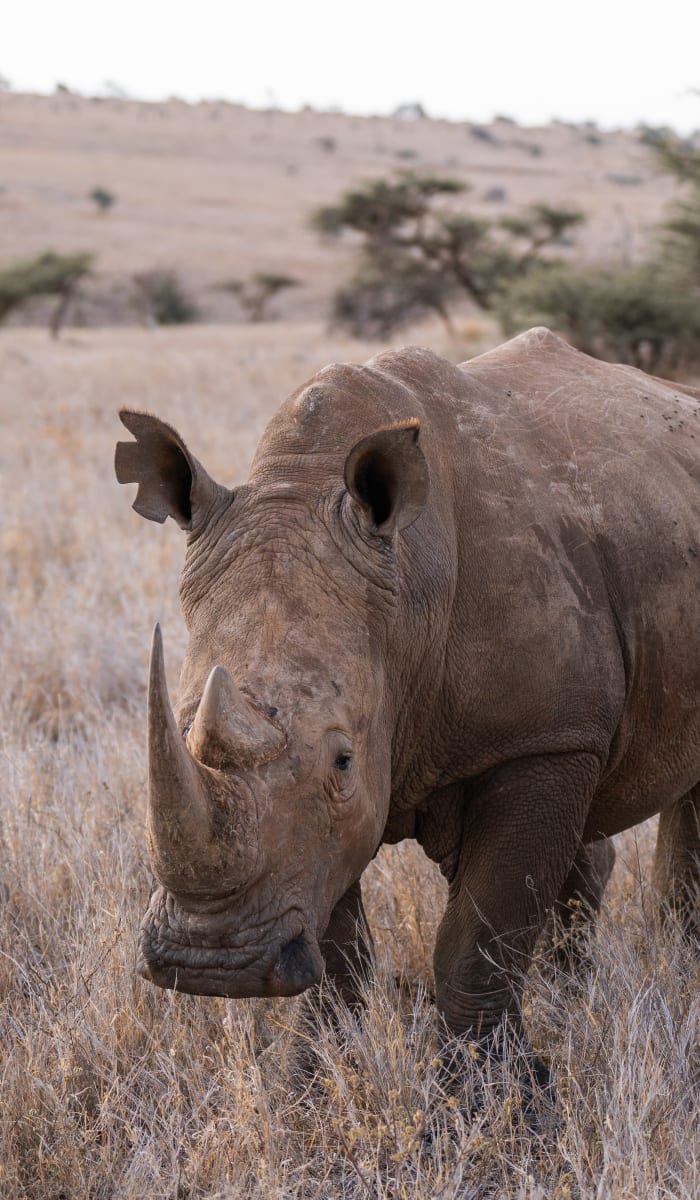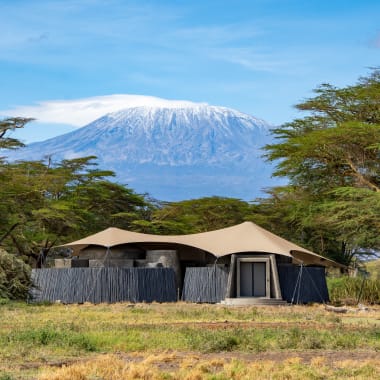
Amboseli National Park
The magic of Amboseli National Park: elephants, culture and Kilimanjaro
The magic of Amboseli National Park: elephants, culture and Kilimanjaro
Welcome to a world where the spectacular beauty of nature has been waiting for you since the beginning of time - welcome to Amboseli National Park. Situated in the shadow of Mount Kilimanjaro, the highest free-standing mountain in the world at an impressive 5,895 metres, this park offers a backdrop that is second to none. The silhouettes of the elephants in front of the snow-capped peak of Kilimanjaro remain immortalised not only in photographs, but also in the hearts of visitors. It is this spectacular panorama that makes Amboseli National Park so special - a perfect symbiosis of majestic wildlife and breathtaking natural scenery.
In addition to elephants, the unique ecosystem of Amboseli National Park is home to an abundance of wildlife, including lions, zebras, giraffes and numerous bird species. The park is also culturally significant: a visit to the Maasai communities offers you fascinating insights into their rich traditions and a way of life that is closely interwoven with nature. Amboseli National Park is therefore much more than a destination: it is a place where you can experience the unspoilt beauty of Africa - a place that will captivate you with its splendour and wild elegance. Prepare to immerse yourself in a world where nature, culture and adventure are combined in the best possible way.
Best time to travel
The best time to visit Amboseli National Park is between July and October
Why Amboseli National Park is so unique
The 392 square kilometre Amboseli National Park at an altitude of 1200 metres is not only a place of incomparable beauty and unspoilt nature, but also one of the most sought-after safari destinations in the world. A whole series of highlights ensure this:
- The undeniable highlight is the breathtaking view of Mount Kilimanjaro, the highest mountain in Africa. This monumental mountain massif, which majestically watches over the landscape, offers a backdrop that is unique on the entire continent. When the golden sun rises over the wide, open plains and bathes the silhouette of Kilimanjaro in a warm, radiant light, the sight makes the heart of every nature and photography enthusiast beat faster.
- Amboseli National Park is famous for its large population of over 800 African elephants, which often approach humans and allow for close encounters. Watching these gentle giants in their natural environment is a privilege and an experience you will remember forever. The animals wander gracefully through the landscape, their imposing figures silhouetted against the backdrop of Mount Kilimanjaro - a truly magical sight.
- The flora and fauna of Amboseli are equally remarkable. The park's landscape is diverse - from dry plains with short grasslands, dense scrub and lush swamps to palm thickets and acacia forests - and thus offers not only a feast for the eyes, but also ideal conditions for a rich biodiversity. With over 300 plant species and an impressive variety of wildlife - in addition to the famous elephant herds, there are lions, giraffes, zebras, buffaloes, jackals and an abundance of bird species - Amboseli is a true pilgrimage destination for nature lovers. The park takes its name from Lake Amboseli, which covers about a third of the park area but is not completely filled with water all year round.
- In addition to its natural splendour, Amboseli National Park also plays an important cultural role. It is home to the Maasai, whose history and traditions are deeply rooted in the landscape. Known for their colourful dress and profound traditions, the Maasai are the custodians of this earth and play a vital role in preserving the ecosystem. This is a rare opportunity for visitors to immerse themselves in the rich culture of the Maasai and experience first-hand how this community lives in harmony with nature.
In its entirety, Amboseli National Park is more than just a place - it is an experience that captures the essence of the African wilderness and combines it with a rich cultural history. Here, where the earth meets the sky and tradition meets modernity, visitors find a world that is both timeless and eternally inspiring.
The wildlife of Amboseli National Park: between big cats and gentle giants
In the heart of Amboseli National Park, a lively panorama of African wildlife unfolds, as diverse and dynamic as can only be found in the vastness of Kenya. This is thanks to the special attitude of the Maasai, who do not tolerate foreign hunters on their territory. As a result, the area has been largely spared from poaching - and a population of around 800 African elephants has been able to survive here. Among them are also older animals, which allows unique insights into the complex social life of these majestic creatures. These gentle giants are known for their local loyalty, strong family bonds and fascinating interactions that attract visitors from all over the world.
Amboseli National Park is not only a protected area, but also a research centre: since 1972, the Amboseli Elephant Research Project has been dedicated to researching the social structures, age distribution and population dynamics of elephants. This year-round continuous monitoring by dedicated game rangers and scientists contributes significantly to the understanding and protection of the famous elephant herds.
A window into the world of African wildlife
In addition to elephants, Amboseli is also home to a rich variety of predators - including lions that lie in wait for prey on the open plains and cheetahs that chase through the grasslands with their incredible speed. The majestic giraffes moving elegantly through the acacia woodlands provide another unforgettable sight. Zebras and gazelles populate the plains, while Cape buffaloes roam the swampy areas.
The behaviour and habitat of these animals are closely linked to the park's ecosystem. During the dry season, the animals gather around the few remaining water sources. This is where breathtaking scenes and interactions between the different species take place. In the rainy season, on the other hand, the wild animals disperse throughout the park and utilise the lush vegetation.
By working closely with local communities, especially the Maasai, strategies are being developed to conserve the various habitats. These measures ensure that Amboseli National Park will remain a place of fascination and wonder for generations to come. Overall, Amboseli National Park offers an unrivalled window into the world of African wildlife - a place where nature can be experienced in its purest form. Here the true beauty of life in the wild is revealed, an eternal spectacle that captivates visitors each time.
Amboseli National Park: Best time to visit, travelling and follow-up activities
The best time to visit Amboseli National Park depends largely on the climatic conditions and animal movements in the region. To enjoy the ultimate safari experience, it is important to take these factors into consideration when planning your visit.
Best time to visit
The dry season, which lasts from June to October, is considered the ideal time for game viewing in Amboseli. During these months, when water is scarce, the animals congregate around the few remaining waterholes. This concentration of wildlife makes it easier to observe elephants, lions and other animals in their natural environment. The vegetation is less dense during this time, which increases visibility and improves the chances of spotting rare and shy animals.
Another attractive time is the short rainy season from November to December. During this phase, the park is transformed into a green paradise, which is particularly attractive for photographers. The wildlife is more active during this time as the temperatures are milder and the availability of water and food increases. The long rainy season from March to May can be less ideal for safaris. During these months, the paths in the park are often difficult to pass due to the rain and the animals are spread over larger areas, which can make observation difficult.
Daytime temperatures vary depending on the time of year. During the dry months from June to October, which are also the coolest months, the average afternoon temperatures are around 26 to 27 degrees. In October, when it gets very hot and humid, it can get a little warmer. In the rainy season, which lasts from November to May, temperatures often reach 30 degrees in the afternoon, especially in February, which is considered the hottest month. Regardless of the time of year, Amboseli National Park offers an unforgettable experience. The mix of dramatic landscapes, abundant wildlife and cultural encounters makes every trip there a unique experience.
How to get there
Amboseli National Park is located about 240 kilometres south-east of Nairobi. Regular domestic flights connect Nairobi with the park's airstrip. The flight takes about 45 minutes. Flights usually depart from Wilson Airport in Nairobi. You can also travel by road - the journey usually takes about three to four hours if you take the Mombasa Road. There are three different entrance gates to the park (north-west, north and east) and the journey time can vary depending on which gate you choose. The roads are mostly tarmac, but the last section to the park can be unpaved and bumpy. A four-wheel drive vehicle is therefore recommended.
Follow-up activities
After a safari adventure in Amboseli National Park, Kenya's white sandy beaches beckon - a wonderful place to relax and listen to the waves on long walks. Another highlight of Kenya is the "Great Migration" in the Masai Mara - a natural spectacle that is unique in the world. Or you can visit Nairobi, the country's exciting capital, where you can discover cultural treasures, get to know historical sites and savour many, many culinary delights.
Unsere Safaris in Kenia
Lodges in Amboseli National Park
To book a trip or for more information, contact us. We'll help you plan and guide you through your upcoming adventure!








